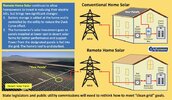This was written very recently by co=founder of SunRun
EXCERPT:
Rather than just have consumers share excess battery capacity with the grid, utilities want to bilk Californians for
the cost of duplicative batteries plus a guaranteed after-tax return of more than 10%. Hawaii made this same
policy mistake in 2016, when it effectively banned power export to the grid. After five years of encouraging
Hawaii residents to build self-consuming solar and storage systems, Hawaii reversed course and created
structures to encourage evening exported power and is now relying on distributed solar to replace power from a
coal-fueled plant. We call on Governor Newsom to not doom California to repeat Hawaii’s mistake. The climate
and power crisis is too urgent.





